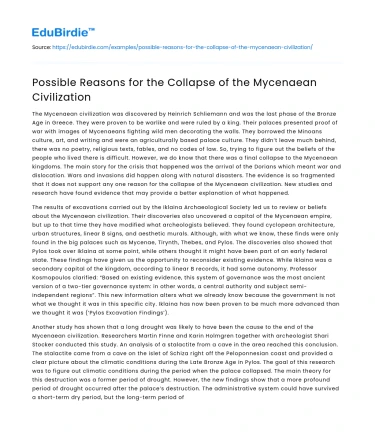The Mycenaean civilization was discovered by Heinrich Schliemann and was the last phase of the Bronze Age in Greece. They were proven to be warlike and were ruled by a king. Their palaces presented proof of war with images of Mycenaeans fighting wild men decorating the walls. They borrowed the Minoans culture, art, and writing and were an agriculturally based palace culture. They didn’t leave much behind, there was no poetry, religious texts, fables, and no codes of law. So, trying to figure out the beliefs of the people who lived there is difficult. However, we do know that there was a final collapse to the Mycenaean kingdoms. The main story for the crisis that happened was the arrival of the Dorians which meant war and dislocation. Wars and invasions did happen along with natural disasters. The evidence is so fragmented that it does not support any one reason for the collapse of the Mycenaean civilization. New studies and research have found evidence that may provide a better explanation of what happened.
The results of excavations carried out by the Iklaina Archaeological Society led us to review or beliefs about the Mycenaean civilization. Their discoveries also uncovered a capital of the Mycenaean empire, but up to that time they have modified what archeologists believed. They found cyclopean architecture, urban structures, linear B signs, and aesthetic murals. Although, with what we know, these finds were only found in the big palaces such as Mycenae, Tirynth, Thebes, and Pylos. The discoveries also showed that Pylos took over Iklaina at some point, while others thought it might have been part of an early federal state. These findings have given us the opportunity to reconsider existing evidence. While Iklaina was a secondary capital of the kingdom, according to linear B records, it had some autonomy. Professor Kosmopoulos clarified: “Based on existing evidence, this system of governance was the most ancient version of a two-tier governance system: in other words, a central authority and subject semi-independent regions”. This new information alters what we already know because the government is not what we thought it was in this specific city. Iklaina has now been proven to be much more advanced than we thought it was (‘Pylos Excavation Findings’).
Save your time!
We can take care of your essay
- Proper editing and formatting
- Free revision, title page, and bibliography
- Flexible prices and money-back guarantee
Another study has shown that a long drought was likely to have been the cause to the end of the Mycenaean civilization. Researchers Martin Finne and Karin Holmgren together with archeologist Shari Stocker conducted this study. An analysis of a stalactite from a cave in the area reached this conclusion. The stalactite came from a cave on the islet of Schiza right off the Peloponnesian coast and provided a clear picture about the climatic conditions during the Late Bronze Age in Pylos. The goal of this research was to figure out climatic conditions during the period when the palace collapsed. The main theory for this destruction was a former period of drought. However, the new findings show that a more profound period of drought occurred after the palace’s destruction. The administrative system could have survived a short-term dry period, but the long-term period of drought that began to develop after the first period would cause the system to fall apart. This period of drought could have contributed to the political and economic order being destabilized. This caused agricultural surpluses to be eliminated, which made it difficult for elites to reform and for the palatial system to be reestablished. Based on what we know from the history books, this study revises traditional interpretations. The main theory for the fall of this civilization is war and invasions, but the history book also says that natural disaster could’ve caused it too. So, this study provides a better explanation of how a drought and climate change could’ve caused the fall of the Mycenaean civilization (‘Navarino Environmental Observatory’).
An investigation has found that the Mycenaean civilization collapsed due to an uprising or invasion. This research was conducted by German archaeologist Joseph Maran and geophysicist Klaus-G. Hinzen. The observations they made from investigating two citadels support the prevailing theory of earthquakes causing the collapse of the civilization. However, non-seismic causes could also explain the seen damage, and some of the structural damage was definitely not caused by earthquakes. Their results show that a destructive earthquake is unlikely to have caused the end to Mycenaean period of the Bronze Age. This research compliments the theory of the Dorian invasion for the final collapse of the Mycenaean civilization (‘New Study Finds’).
Mycenaean Greece represents mainland Greece’s first advance civilization with its palatial states, urban organization, art works, and writing system. A warrior elite society dominated this area and consisted of a network of palace states that developed rigid hierarchical, political, social, and economic systems. Mycenaean Greece crumbled in the eastern Mediterranean with the collapse of the Bronze Age. Numerous hypotheses were proposed for the demise of this culture, including the Dorian invasion and actions related to the ‘Sea Peoples’. Other explanations have also been suggested, such as natural disasters and climate change. With numerous evidence pointing in different directions of what could have been the cause of the collapse of the civilization, there is no way to know for sure what happened.






 Stuck on your essay?
Stuck on your essay?

